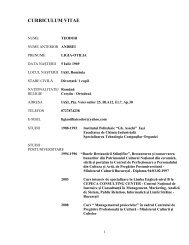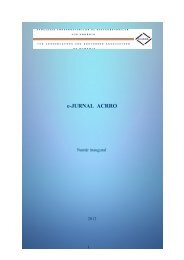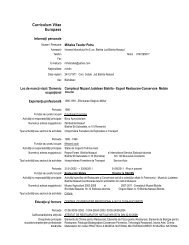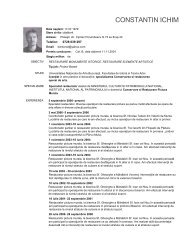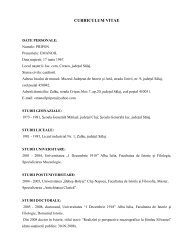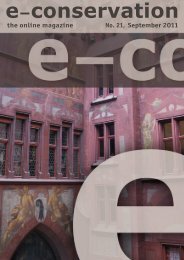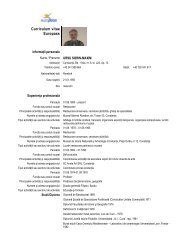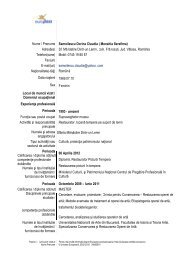e-conservation the online Magazine 16, oct 2010.pdf
e-conservation the online Magazine 16, oct 2010.pdf
e-conservation the online Magazine 16, oct 2010.pdf
You also want an ePaper? Increase the reach of your titles
YUMPU automatically turns print PDFs into web optimized ePapers that Google loves.
MICROBIAL STUDY OF EGYPTIAN MUMMIES<br />
Figure 7. Collecting and removal of dirt particles and fungal<br />
growths from a mummy.<br />
Figure 8. The necessary tools for conservator' health and<br />
safety (masks, gloves, goggles).<br />
isolated fungal strains from <strong>the</strong> Egyptian mummies<br />
to produce various amounts of extracellular enzymes<br />
(Avicelase, CMCase and cellobiase) which<br />
may lead to <strong>the</strong> decomposition of <strong>the</strong> mummy<br />
materials. Benlate, thymol and cedar oil show an<br />
ability to inhibit fungal growth. The authors would<br />
like to recommend creating better preventive <strong>conservation</strong><br />
procedures in order to preserve <strong>the</strong> mummies<br />
from future damage.<br />
References<br />
[1] A. E. David, “Conservation of mummified Egyptian<br />
Remains”, in A. R. David (ed.), in Science<br />
in Egyptology: proceedings of <strong>the</strong> Science in<br />
Egyptology Symposia, Manchester University<br />
Press, Manchester, 1986.<br />
[2] A. Arya, A. R. Shah, and S. Sadasivan, “Indoor<br />
aeromycoflora of Baroda museum and deterioration<br />
of Egyptian mummy”, Current Science<br />
81(7), 2001, URL<br />
[3] P.H. Gregory, Microbiology of <strong>the</strong> Atmosphere,<br />
Leonard Hill Books, Aylesbury, England, 1973,<br />
pp. 377<br />
[4] A. F. Sahab, F. Tawfic, S. Sahaba, and S. Mous-<br />
tafa, “Indoor fungal airospora and microorganisms<br />
communities associated with old manuscripts<br />
of GEBO of Egypt”, Journal of Agricultural<br />
Sciences 28(8), Mansoura University,<br />
2003, pp. 6055- 6063<br />
[5] K. Zielinska-Jankiewicz, A. Kozajda, M. Piotrowska,<br />
and I. Szadkowska-Stanczyk, “Microbiological<br />
contamination in moulds in work<br />
environment in libraries and archive storage<br />
facilities”, Annals of Agricultural and Environmental<br />
Medicine 15, 2008, pp. 71-78<br />
[6] R. López-Martínez, F. Hernández-Hernández,<br />
B.E. Millán-Chiu, P. Manzano-Gayosso, and L.<br />
J. Méndez-Tovar, “Effectiveness of imazalil to<br />
control <strong>the</strong> effect of fungal deterioration on<br />
mummies at <strong>the</strong> Mexico City Museum ‘El Carmen’”<br />
(article in Spanish), Revista Iberoamericana<br />
de Micología 24, 2007, pp. 283-288<br />
[7] R. A. Zabel, and J. J. Morrell, Wood microbiology:<br />
decay and its prevention, Academic<br />
Press, San Diego, 1992<br />
[8] T. Reinikainen, K. Henriksson, M. Siika-aho,<br />
O. Teleman and K. Poutanen, “Low-level endoglucanase<br />
contamination in a Trichoderma<br />
e-<strong>conservation</strong><br />
47



